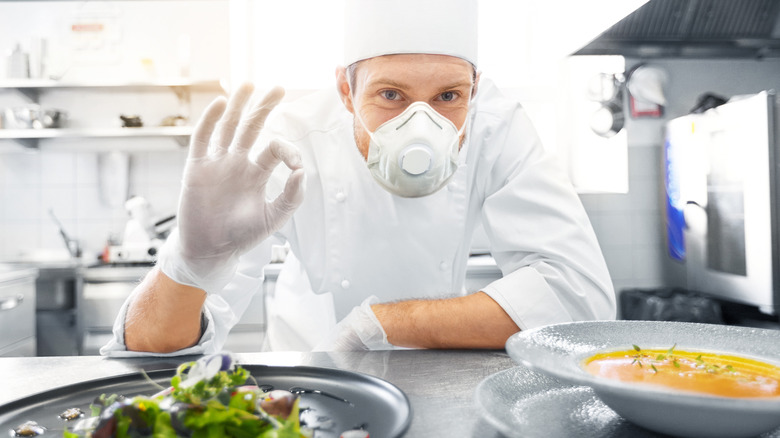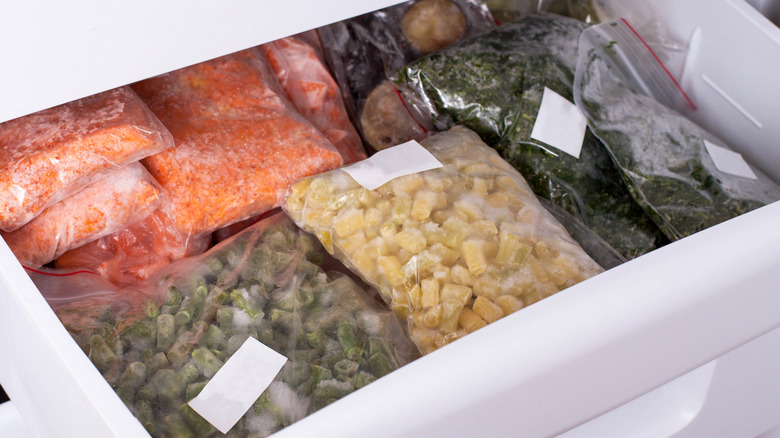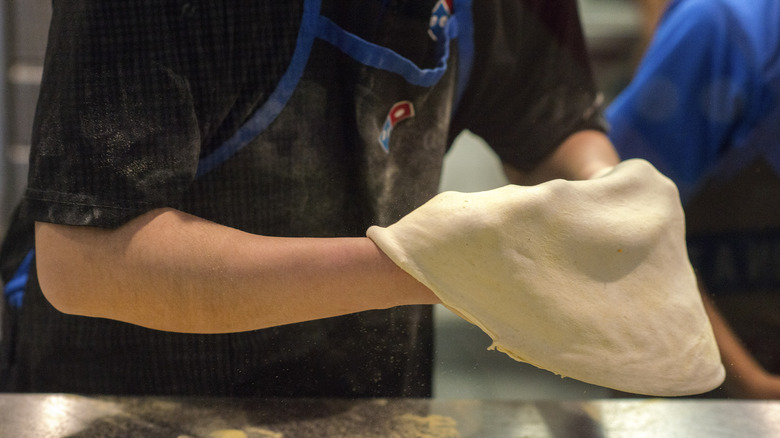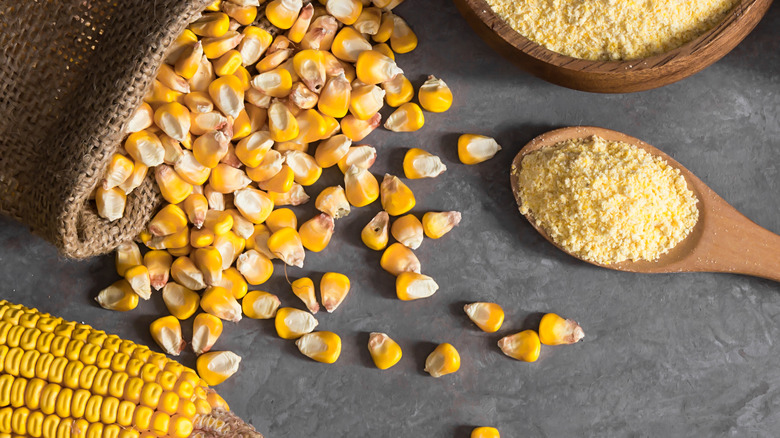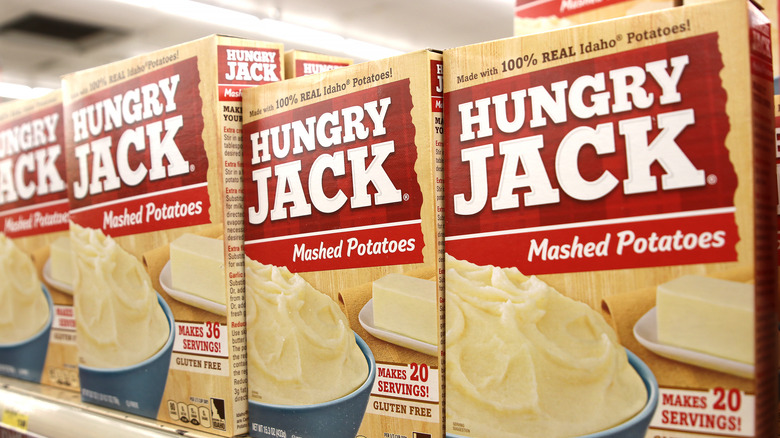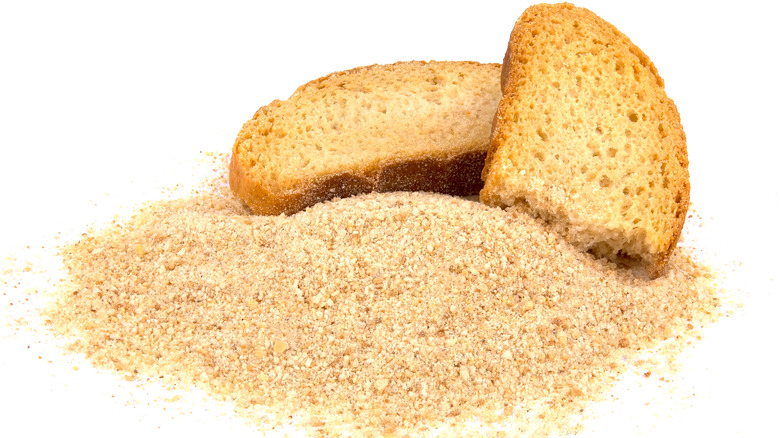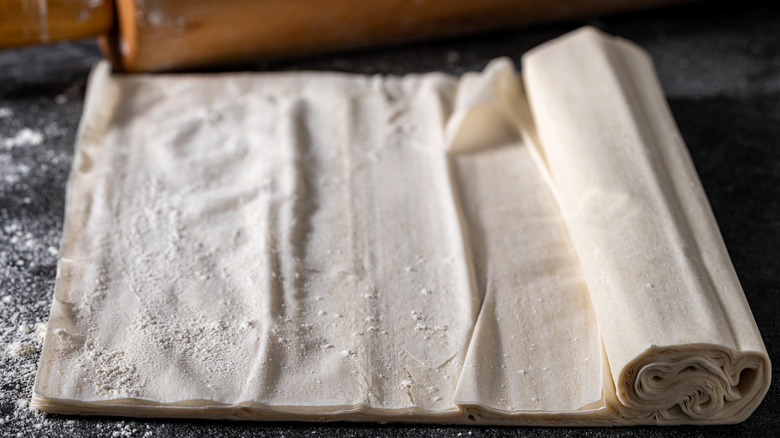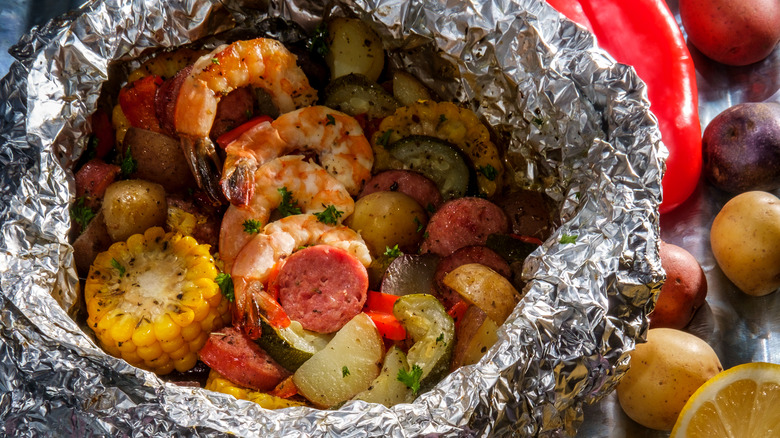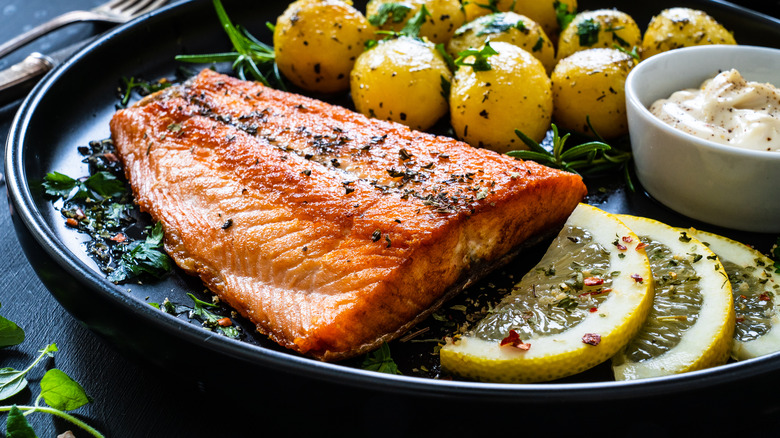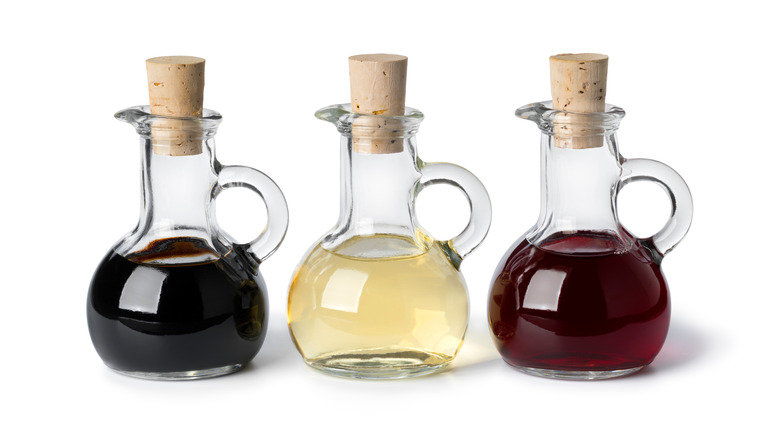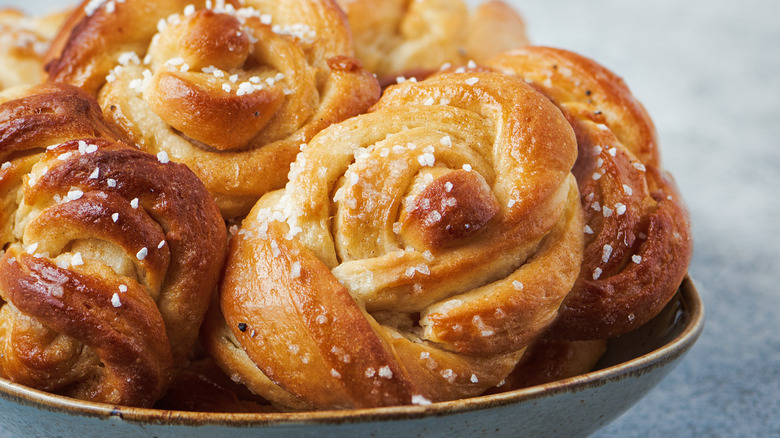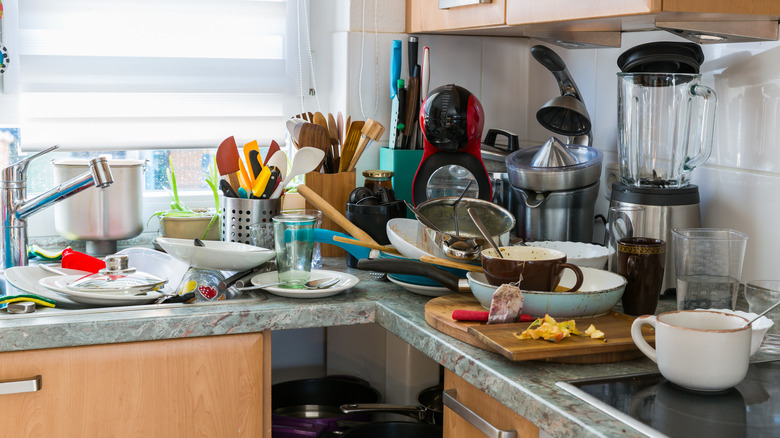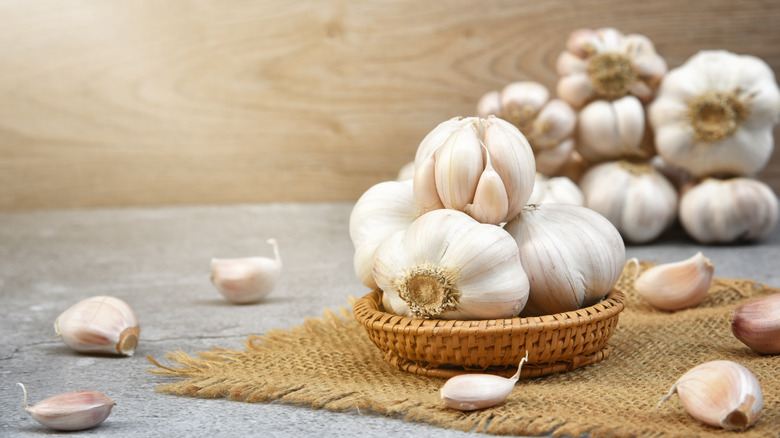Shortcuts Chefs Don't Want You To Know About
There are legitimate reasons why trained chefs pay out the nose to attend culinary school. It may come as no surprise that cooking Michelin Star-level meals really is an art and a science that requires a considerable amount of training, experience, and skill. So, while there are some tricks to the trade of cooking, and there are some skills that take a lot of time, practice, and finesse to master.
That said, not everything about cooking is as challenging as chefs might like you to believe. Obviously, the great majority of professional chefs want you to rave about their cooking and pay for their meals when you're looking for a nice dining experience. But there are a lot of shortcuts and cooking hacks that chefs use to cut down on prep time, amplify the flavor of their foods, and just generally make their work in the kitchen a little easier to manage. Of course, these "tricks of the trade" are accessible enough that anyone can try them, you just have to know what they are. Luckily, a few trained chefs have let the cat out of the bag, so to speak, about a few of the shortcuts they use to make cooking easier.
Use frozen fruits and veggies
When you think about chefs "throwing down" in the kitchen, you probably imagine a fridge stocked with fresh fruits and veggies just ready to be sliced and diced into the dish of the day. And of course, that's true for a lot of things. A salad needs to be made with fresh lettuce and produce, after all. A pretty garnish on a pastry must be made from fresh fruit. But for dishes that have to be cooked? There's a lot to be said for the beauty of frozen produce, which can last an extraordinarily long time and are often just as nutritious as fresh produce. Chefs who chimed in for an article on SheerLuxe weren't shy about sharing their favorite frozen produce items. Frozen peas topped the list of several chefs, including Christopher Lyon, Lawrence Gomez, Monika Linton, and Neuza Leal, but sweet corn, frozen fruits, and pearl onions also made the list.
Possibly the most interesting frozen veggie to be suggested? Edson Diaz-Fuentes said he likes to freeze ripe avocados. This is genius if you always happen to miss the "window" for using an avocado at its prime. "I never use them for guacamole (always use fresh for guac) but the creaminess is great for shakes," he says. "I add the frozen avocado to carrot, celery, orange juice, and a pinch of spirulina for a great veggie shake."
Buy pizza dough from your local pizzeria
Look, if you want to try your hand at making homemade pizza dough, you can certainly do so. But really, when it's pizza night at home, you often want the luxury of simply throwing toppings on premade dough and cooking that bad boy up in no time. Having pizza dough on hand certainly speeds up the process.
But, while grabbing just such a dough from a cold case at the store isn't quite where it's at. Chef and pizza connoisseur Donatella Arpaia told Long Island Weekly that you should actually skip the pre-made doughs available at the grocery store, emphasizing that having truly good dough is the foundation on which to build a good home pizza. "When you have a beautiful dough, you have a great pizza," she said.
So, where to get the good stuff? If you have a favorite local pizza joint, call them up and ask if they're willing to sell you some raw dough. This might not fly at chain places, but local pizzerias are more likely to be willing to part ways with some of their dough. Once you've procured the dough, just store it in the freezer (or the fridge if you're looking to make your pizza the same day), and pull it out when it's time to start cooking.
Use cornmeal flour when cooking homemade pizza
You know how artisan pizzas from the best pizzerias often have a slightly rough texture on the bottom? Chances are, what you're feeling, tasting, and experiencing is cornmeal. Chef Donatella Arpaia told Long Island Weekly that a big part of a delicious, homemade pizza, is how the crust is baked. In addition to "parbaking," where you pre-cook the crust without its toppings for a few minutes before adding the rest of the ingredients, you should use an extra hot oven, a pizza stone (if you have one), and cornmeal flour.
To enact this trick, you simply put the cornmeal flour on your pizza stone or your (pre-heated) pan before you place the dough for the crust on top. Easy as it is, this step provides some serious additional flavor. "The cornmeal flour underneath provides a nutty, crispy flavor," Arpaia said. Not to mention, it creates that professional, "made in a pizzeria" taste and feel that can be hard to emulate when cooking at home.
Bread your proteins with instant mashed potatoes
Sure, you can buy a box of breadcrumbs at the grocery store and easily use them for all your breading needs ... that is, unless you have celiac disease, or a gluten allergy or intolerance. In that case, basic breadcrumbs are a recipe for gastrointestinal disaster. But if you can't fathom ditching your favorite meatball, meatloaf, or fried chicken recipe, you don't have to. According to Andrea Sprague, a writer for The Holistic Chef, potato flakes can sub in and do the trick as a gluten-free alternative to breadcrumbs.
The first trick is making sure you're buying potato flakes without gluten cross-contamination (Sprague suggests the Bob's Red Mill brand), but then, you simply use them as you would use breadcrumbs to help create the right texture, moisture level, and flavor in recipes like meatballs and meatloaf. If you want to use potato flakes to crisp up the outside of your chicken or fish, Sprague points to Food & Wine magazine to provide guidance on getting the gluten-free breading right (for instance, this recipe for crusted cod combines potato flakes with rice flour).
Thicken sauces with leftover bread
On the other hand, if you don't have any problem with gluten, chefs know how to put breadcrumbs to use in ways that the everyday home cook may not think of. For instance, in a thread for professional chefs on Chef Talk, pro cooks suggest using leftover or dried-out bread as an easy way to thicken sauces and soups. The key to this method is not to use fresh bread. Rather, you need to use older bread to get the right sort of texture in the final product. For this trick, you can go nuts and try different types — French, Italian, sourdough, or even basic sandwich bread.
It's important that the bread in question is dried out, too, so the bread crumbs will actually soak up the other wet ingredients in the soup or sauce to help thicken it up. While you can throw chunks of dried bread into a sauce as it's cooking, your best bet is to run the dried bread through a food processor first so that it's broken down into crumbs. Then, simply stir the crumbs into your soup or sauce so that they're well-distributed. Then, cook away! The crumbs will soak up the sauce or soup and make it thicker and heartier!
Get acquainted with phyllo
If you've ever wondered how chefs make some of their incredibly flaky, flavorful pastries and dishes, the answer just might lie in phyllo dough. You can buy this dough pre-made at most grocery stores and, with a little practice, you can make wontons, baklava, and other flaky pastries like a pro.
Of course, playing with the paper-thin and easily torn pastry dough can feel intimidating, but chef Marti Sousanis told The Washington Post that the dough isn't nearly as challenging as some chefs would have you believe. "It's just like playing with clay. You can make of it what you will. Once you start playing with it you will see how easy it is to work with and you'll create your own fancy shapes," Sousanis said.
And if you've already mastered using pie crusts or other pastry dough for a few recipes, you can start your experiments by subbing in phyllo to get a flakier taste and texture.
Make shrimp in a foil packet for better flavor
You may think of foil packets as a cooking method reserved for campfire cookouts or for college kids without proper pots and pans, but real chefs know that foil packets are an excellent way to lock in flavor. In fact, Melissa Gaman, a test kitchen chef writing for Food Network, turns to foil packets whenever grilling up shrimp scampi. Now, grilling shrimp is a delicious way to go, but you risk having the shrimp fall through the grates of the grill, a true cookout tragedy. And if you're not paying attention, you can overcook the seafood quickly and will have to deal with rubbery shrimp. And surely we all agree that tough, dry shrimp doesn't make for the best dinner.
By grilling the shrimp (and all the other ingredients, while you're at it) inside a packet of foil, you lock in the flavor and moisture while retaining all the juices. You also don't have to worry about all the tasty stuff falling through the grate. The result is shrimp and sauce that is even better than the original scampi, perfect for topping salad or pasta.
Use mayonnaise to keep fish from drying out
Unless you're making a fish sandwich, you probably don't pull out the mayonnaise when you're prepping a fish dinner. But test kitchen chef Melissa Gaman, writing for Food Network, says that mayonnaise is quite simply one of the best "hacks" around for preventing your fish from ending up dry. If you think of mayonnaise working on fish kind of like cocoa butter works for your skin, it essentially offers a layer of fat that will help to keep the fish from drying out while cooking. And, if you happen to be grilling your fish, Gaman points out that mayonnaise can also add an important nonstick function to the whole process, preventing the fish from sticking to your grill.
Of course, like other fats (such as butter and oils) that you add to your fish, mayonnaise will impart a flavor as well. It may not taste exactly like the flavor you're used to, but Gaman insists the result is "subtle and rich," so it's definitely worth giving it a try.
When tempted to add more salt, try some vinegar instead
In a Reddit thread asking chefs for their favorite ingredient, Redditor HEAT_IS_DIE pointed directly to vinegar, stating that it's a great ingredient to try when you think a meal needs more salt. "It is often the thing that is missing when people go for more salt and spices in their cooking, wondering why it doesn't taste quite as good as in a restaurant."
Of course, some people can't palate vinegar, but the reasoning comes down to the acidic nature of the food. Redditor dakunut responded to the original comment by emphasizing, "The addition of acid to a dish is game changing. The way salt and acid work together in cooking is ridiculous." User coleosis1414 took the explanation a little further, writing that "If your food is bland and you can't seem to add enough salt, add a little bit of acid. Vinegar, lime juice, lemon juice; in small enough quantities they're nearly interchangeable."
In other words, if you like vinegar and your food is bland, add a little vinegar. Of course, if you don't like vinegar and your food is still annoyingly bland, try adding lemon or lime juice before you add salt. And remember to keep the amounts small — use just a splash at a time — and see how the flavor affects your food. You could be very pleasantly surprised.
Try adding cardamom to baked goods
When you're getting ready to bake a batch of cookies or banana bread, consider setting the cinnamon or nutmeg aside and grab some cardamom for a new take on your favorite baked goods. In a Reddit thread of chefs sharing their favorite ingredients, baker DaygloDago said, "It's still not super common in American baked goods, and while I love cinnamon, that flavor isn't special to my palette anymore. Cardomom gives such a warm, floral scent/flavor to whatever you make, and can be paired with so many things. Treat yourself: add some cardamom and orange zest to your next batch of banana bread."
Clearly, DaygloDago was onto something because the comment resulted in almost 11,000 upvotes and thousands of additional responses. Most responders chimed in with similar suggestions, saying you should try adding cardamom to any baked good that calls for cinnamon or nutmeg, and that you can even add it to your coffee. If you're not already on the cardamom train, consider joining in and trying this unique flavor for yourself.
Cut down on cleaning with laundry soap - but only in some conditions
If anyone is familiar with facing an overwhelming number of dirty dishes, it's someone who works in a professional kitchen. Even if chefs aren't responsible for cleaning every plate, knife, and spoon that runs through the restaurant, they're bound to pick up a few tricks of the trade to make the cleaning process as quick and easy as possible.
In an interview with the Mirror, chef Rosie Reynolds shared her "hacks" for kitchen time-saving, which includes the possible use of laundry detergent. "To wash away stuck-on grime, use a little laundry washing powder as the detergent breaks down grease effectively and quickly," she said. Note that she specifies "powder," though, meaning you shouldn't reach for the liquid soap, which isn't as abrasive as the powdered stuff and may not cut through grease when you do start scrubbing.
However, there is an important caution here. You must pay careful attention to the label on the soap, lest you start piling some non-food-safe additives onto your dishes. Tutor Clean notes that a few common detergent features, like fragrances and brighteners, might also release toxic gases when heated in a dishwasher. And any additive residues that are left behind while handwashing aren't necessarily food-safe, either. You may be okay to use very pared-down, additive-free laundry soap, however. Just proceed with caution and be sure to triple-check that ingredients list first if you really want to try this at home.
When you add garlic makes a big difference in flavor
Garlic — if you love it, you probably really love it. And if you don't, you probably hate the stuff. Regardless, there's more to adding these small and highly aromatic white cloves to your food than simply deciding how to cut your garlic and how much to add to a dish. According to a Reddit thread with chefs sharing cooking tips, Reddit user Orbnotacus said, "The amount of garlic flavor is dependent on when you add the garlic. Add it early for light flavor, add it late for bold flavor." The simple comment garnered more than 30 thousand upvotes and a slew of responses that amplify how important this little tidbit of information really is.
If you've ever bitten into a raw clove of garlic, then you already know that the flavor is strong, to the point of being overwhelming. But when garlic has been cooking for a while, the flavor mellows considerably. By adding garlic late in the game, you'll end up with garlic that has more of a bite.
Another tip on garlic intensity was added to the thread by TheMightyRasputin who stated, "It also depends heavily on how you treat the garlic pre-adding it. The more processed the garlic, the more 'garlicky' the flavor. Whole cloves or very roughly chopped ones give you a milder flavor and will last longer in the heat. Finely minced or better yet, grated, garlic will give you a sharper, spicier flavor."
